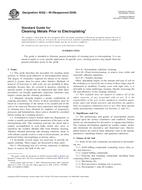Potřebujeme váš souhlas k využití jednotlivých dat, aby se vám mimo jiné mohly ukazovat informace týkající se vašich zájmů. Souhlas udělíte kliknutím na tlačítko „OK“.
ASTM B322-99(2009)
Standard Guide for Cleaning Metals Prior to Electroplating
Automaticky přeložený název:
Standardní Průvodce pro čištění kovů Před Galvanotechnika
NORMA vydána dne 1.9.2009
Informace o normě:
Označení normy: ASTM B322-99(2009)
Poznámka: NEPLATNÁ
Datum vydání normy: 1.9.2009
Kód zboží: NS-6230
Počet stran: 9
Přibližná hmotnost: 27 g (0.06 liber)
Země: Americká technická norma
Kategorie: Technické normy ASTM
Anotace textu normy ASTM B322-99(2009) :
Keywords:
Biological cleaners, Descaling, Electroplated coatings, Metal cleaners, Metallic coatings, Specimen preparation (general)--electroplating, Surface descaling/cleaning, ICS Number Code 25.220.40 (Metallic coatings)
Doplňující informace
| Significance and Use |
|
The performance and quality of electroplated articles depend upon the surface cleanliness and condition. Various metals are electroplated for decorative or engineering finishes. The common electroplates applied are usually copper, nickel, and chromium for decorative and functional uses. Electroplated articles are used in many industries such as the marine, automotive, plumbing fixtures, and appliance industries. |
| 1. Scope |
|
1.1 This guide describes the procedure for cleaning metal surfaces to obtain good adhesion of electrodeposited metals. The degree of cleanliness required for metals to be electroplated is greater than for most other finishes. Methods of removal of heat-treat or mill scale are not included in these methods, because they are covered in practices referring to specific metals. It should also be understood that while these procedures are broadly applicable, particular substrates may require certain specific cleaning procedures. 1.2 Adequate cleaning requires a proper combination of cleaning procedures. The choice of these procedures must be based on a knowledge of the metals to be cleaned and of the soils to be removed. Because most experience and knowledge in cleaning have been obtained by suppliers of proprietary processes and formulations, these sources should be consulted before setting up a cleaning process. 1.3 A treatment to remove tarnish, light rust, fingerprints, or oxides is usually provided before immersion of the piece in the electroplating tank. This treatment activates the metal and is usually accomplished in acid baths which also serve to neutralize the residual alkaline film from alkaline cleaning. Alkaline chelated derusting and cleaning solutions, alone or with sodium cyanide, used as a soak or electrocleaner, are often preferred before electroplating on ferrous alloys. 1.4 Invariably several stages are necessary to provide adequate cleaning. These stages are discussed in three parts: Part I—Precleaning (use of a solvent, emulsion, or alkaline spray) to remove the bulk of the soil. Part II—Intermediate (alkaline) cleaning. Part III—Final electrocleaning, to remove trace solids and especially adherent impurities. Part IV—Trouble shooting. Often, depending largely on the amount and type of soil on the workpieces as received, one or more of these stages may be eliminated or modified. Usually, even with light soils, it is advisable to retain multistage cleaning, thereby increasing the life and efficiency of the cleaning solutions. 1.5 This standard does not purport to address all of the safety concerns, if any, associated with its use. It is the responsibility of the user of this standard to establish appropriate safety and health practices and determine the applicability of regulatory limitations prior to use. (For more specific safety precautionary statements see Sections 11 and 16.) |




 Cookies
Cookies
